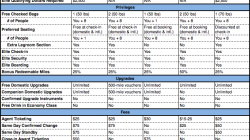The answer to that question is a pretty solid “no” within the same program. Better status automatically means better benefits. But between programs?
Often the question is: “I fly X miles a year, so which program is best for that amount of travel?” It’s a step in the right direction yet it’s still a comparison of all top tiers or all mid tiers or all low tiers. After reading some emails from readers and chatting with friends this weekend, it’s become more apparent that for some people, relatively low status with one program can be more rewarding than high status with another. I’ll start with my own situation…
This year I’m trying to obtain MVP Gold status with Alaska Airlines and Executive Platinum status with American Airlines. Alaska’s MVP Gold requires 40,000 miles if I fly exclusively on Alaska American’s Executive Platinum requires 100,000 miles. For me personally, I’m much more looking forward to MVP Gold status even though it requires half as much flying to earn.
What really seals the deal is the flexibility to rebook my flights without a change fee. I just wrote about this last week, which is partly why I got emails from my readers on this topic. Ed told me he flies 150,000 miles a year, the majority on Alaska, and wondered if it would be better to earn Executive Platinum with American instead. But I agreed with his hesitation. He said he really values the ability to cancel flights, doesn’t think the domestic upgrade situation is necessarily better with American, and doesn’t know that he’ll use the systemwide upgrades.
This is the first year that my wife, Megan, will do any better than Silver status with any program. I told her she really, really needs to push for MVP Gold. Once Megan and I both earn MVP Gold status we’ll have the flexibility we need it comes to booking vacations and family visits. There have been times when a trip was taken off the table because fares doubled in the time between concept and execution.
It’s not a question of upgrades or service or even the value of the miles. It’s about do we travel or not?
On a recent flight I ran into one of my readers, Husain, and his wife who talked about reaching MVP Gold 75K so that they can gift MVP status to family. This makes it easier for their less frequently flying loved ones to get a better seat or a free checked bag. But they admitted this was just icing on the cake. The flexibility offered by a lower tier, MVP Gold, was the main objective so that their own travel was more flexible.
So yes, in the examples of Ed, Husain, and me, earning the benefits of a middle tier are more valuable than the benefits of a higher tier with another program. It’s not really about how high you rank in your own program or even about comparing entire tiers between programs. It’s all about figuring out what benefits you value and then finding a program that offers them — at whatever tier that happens to be.
An international traveler whose company always books the cheapest coach fare will probably be well served by American Airlines and its flexible systemwide upgrades. Someone who frequents Asia may want to consider Delta instead given their larger network in that region. United offers very generous spousal benefits for those who travel enough to earn lifetime status — I know another reader who earned lifetime Global Services for him and his wife after 4 million miles flown. Delta and United will soon have programs that award more miles to people who pay (or whose companies pay) more money for their tickets. You can learn more about these programs in my Airline Loyalty Comparison Tables.
Each of these carriers, and each tier in their respective loyalty programs, works best for a different kind of traveler. I still do enough international travel and travel to smaller airports that I think American’s Executive Platinum tier is valuable. But if forced to choose only one, even if I was flying enough to quality for either, I’d probably prefer Alaska’s lower profile MVP Gold tier.

